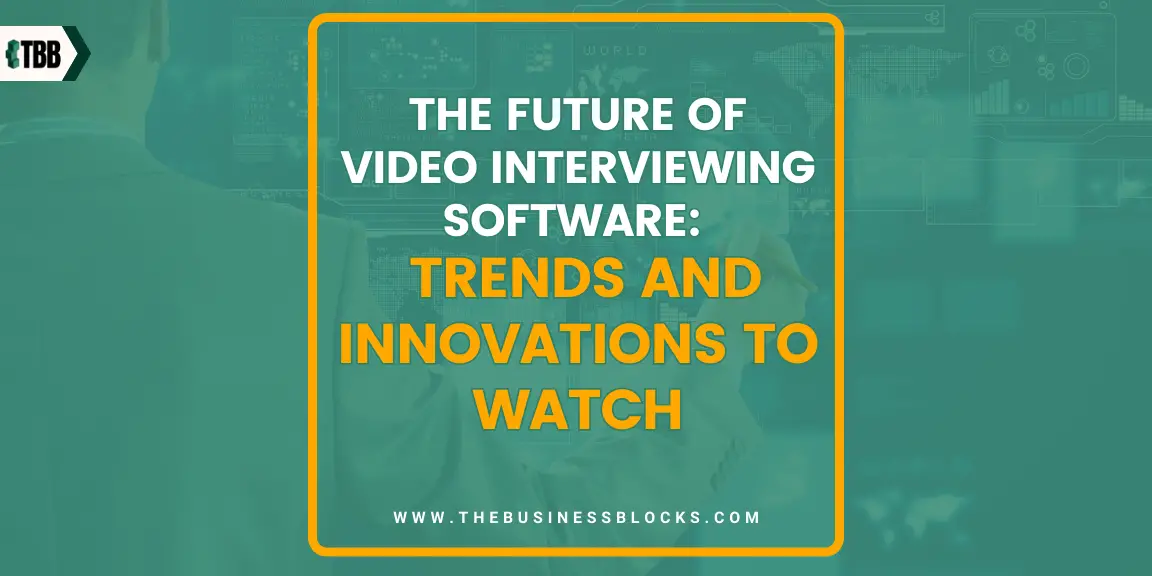The future of video interviewing software is poised to revolutionize recruitment, with emerging trends and innovations shaping the landscape. From AI-driven analysis to enhanced candidate experience, today we’ll explore the exciting developments in video interviewing software. In the process, you’ll get valuable insights into the trends that will drive the future of hiring.
Are you looking for the latest trends and innovations in video interviewing software?
As the demand for virtual recruiting continues to rise, emerging technologies are introducing more efficient and reliable ways of connecting with potential talent. Keep reading to discover the current state of video interviews and key developments impacting how recruiters make hires.
Get ahead in your hiring plans by staying informed on cutting-edge advances using HR technology like artificial intelligence (AI) powered video interviewing platforms, Integrated voice recognition systems, and automated scheduling tools. Plus, gain insight into features such as real-time collaboration tools designed to quickly review candidates with colleagues– helping you save time throughout the recruitment process!
Read this detailed article now to learn all about the future of video interviews!
What is Video Interviewing Software, and how can you use it to your advantage?

The future of hr software is enhancing recruiting processes and making them more efficient. Video interviewing software is an easy-to-use platform that allows employers to interview potential candidates from anywhere in the world. Candidates can connect through their laptop, tablet, or mobile device and be interviewed instantly by recruiters without needing to travel or take time away from work.
Human resource management or HR managers are automating the interviewing process with video interviewing software. This HR software commonly includes automated scheduling, real-time collaboration tools, integrated voice recognition systems, and AI-driven analysis which you can use to your advantage for a more efficient recruitment process.
Future HR technology trends will continue to revolutionize recruitment. By analyzing large data sets, these platforms can quickly scan hundreds of candidate applications and highlight the best matches for the job. Additionally, AI-driven video interviewing software can provide instant feedback on potential candidates, helping recruiters or HR departments identify the right candidates faster.
Overview of the Current Trends in Video Interviewing Software Technology
Video interviewing software technology is evolving rapidly, incorporating innovative features and advancements. Here is an overview of the current trends shaping the industry:
AI-Powered Analytics
- AI algorithms analyze candidate responses, facial expressions, and body language, providing valuable insights for evaluation and decision-making.
- Automated sentiment analysis helps gauge candidate engagement and suitability.
Mobile-Friendly Solutions
- Video interviewing software is increasingly optimized for mobile devices, allowing candidates to participate conveniently from anywhere.
- Mobile apps provide flexibility and ease of use, enhancing the candidate experience.
Virtual Reality (VR) Integration
- VR technology is integrated into video interviewing software, creating immersive interview experiences.
- VR simulations assess a candidate’s skills and performance in a simulated work environment.
Multilingual and Translation Capabilities
- Video interviewing software supports multilingual interviews, breaking language barriers in the global recruitment landscape.
- Real-time translation features facilitate seamless communication between candidates and interviewers.
Collaboration and Feedback Tools
- Enhanced collaboration features enable multiple interviewers to participate simultaneously, promoting effective panel interviews.
- Feedback tools streamline the evaluation process and facilitate collaborative decision-making.
Integrations with Applicant Tracking Systems (ATS)
- Seamless integration with ATS platforms enables a unified recruitment workflow, ensuring a smooth transition from interviews to candidate management.
- Data synchronization between video interviewing software and ATS improves accuracy and reduces manual effort.
- These trends showcase the expanding possibilities of video interviewing software, enhancing recruitment efficiency, candidate evaluation, and overall hiring outcomes.
Predictions for the Future of Video Interviewing Software Solutions

As the recruitment landscape continues to evolve, the future of hr software or video interviewing software solutions is poised to play a pivotal role in the future of hiring. Here are some predictions for the advancements we can expect in this technology:
Seamless Integration of AI and Machine Learning
With the exponential growth of AI and machine learning, video interviewing software will harness these technologies to provide more accurate candidate assessments. Advanced algorithms will analyze facial expressions, tone of voice, and non-verbal cues, providing deeper insights into candidate suitability.
Virtual Reality (VR) Enhanced Assessments
VR integration will revolutionize candidate assessments by immersing them in realistic virtual environments. This technology will enable recruiters to evaluate candidates’ skills, problem-solving abilities, and cultural fit in simulated work scenarios, enhancing the accuracy and efficiency of hiring decisions.
Enhanced Candidate Experience
The future of video interviewing software will focus on optimizing the candidate experience. Solutions will prioritize user-friendly interfaces, mobile accessibility, and personalized interactions to create a seamless and engaging interview process. Customizable branding options will enable businesses to provide a consistent and compelling employer brand experience.
Enhanced Data Analytics and Predictive Insights
Video interviewing software will leverage robust data analytics to give recruiters actionable insights. Predictive analytics will help identify top candidates, assess future job performance, and enhance talent acquisition strategies. This data-driven approach will empower recruiters to make more informed and data-backed hiring decisions.
Ethical and Inclusive Technologies
Future video interviewing software solutions will address concerns related to bias and inclusivity. Ethical AI algorithms will be designed to mitigate bias and promote diversity throughout the recruitment process. Accessibility features will ensure inclusivity for candidates with disabilities.
Seamless Integration with HR Tech Ecosystem
Video interviewing software integrates with other HR technologies, such as applicant tracking systems (ATS), talent management platforms, and HR analytics tools. This integration will create a unified ecosystem that streamlines the end-to-end recruitment process, improves data accuracy, and enhances collaboration among HR professionals.
Advantages and Disadvantages of Using Automation in HR

Automation in HR processes offers both advantages and disadvantages. Here is an exploration of the benefits and drawbacks:
Advantages
Increased Efficiency
Automation streamlines HR operations, eliminating manual tasks and allowing HR professionals to focus on strategic activities.
Enhanced Accuracy
Automated systems reduce human error, ensuring accurate and reliable HR data management.
Improved Compliance and Reporting
Automation facilitates accurate record-keeping, monitors compliance deadlines, and generates reports effortlessly.
Streamlined Recruitment and Onboarding
Automation simplifies and accelerates the recruitment and onboarding processes, improving the candidate experience and reducing time-to-fill.
Data-Driven Decision-Making
Automated HR systems provide robust analytics and reporting capabilities, enabling evidence-based decision-making and strategic workforce planning.
Disadvantages
Initial Implementation Challenges
Implementing automation requires time, resources, and expertise, with potential system integration and training complexities.
Potential Cost
Initial investment costs may be associated with software, hardware, and implementation.
Reduced Human Interaction
Automation may impact employee engagement and the personal touch in HR processes, requiring a balance to maintain human connection.
Dependency on Technology
Relying heavily on automation can create vulnerabilities in technical issues or system downtime.
Potential Resistance to Change
Introducing automation may face resistance from employees accustomed to traditional methods, necessitating effective change management strategies.
By carefully considering these advantages and disadvantages, organizations can make informed decisions on leveraging automation effectively in HR processes.
Benefits of Implementing a Cloud-Based Solution

Implementing a cloud-based solution for HR processes offers significant advantages, including enhanced security and predictive analytics for compliance. Cloud providers ensure data encryption, access controls, and regular backups, providing robust security measures. Additionally, cloud-based HR systems leverage predictive analytics to identify compliance risks and enable proactive measures. With these benefits, organizations can streamline HR operations, strengthen data security, and maintain regulatory compliance.
Tips: How to Choose the Right Video Interviewing Software for Your Business
Here’s a checklist for you to choose the right video interviewing software for your business:
- Assess your specific needs and requirements.
- Evaluate the software’s features and functionality.
- Consider integration capabilities with existing HR systems.
- Ensure a user-friendly interface and ease of implementation.
- Check for compatibility with different devices and operating systems.
- Research vendor reputation, customer reviews, and support services.
- Request demos or trial periods to test the software’s performance.
- Consider scalability and future growth potential.
- Analyze pricing models and the total cost of ownership.
- Seek recommendations and insights from industry peers or HR professionals.
How to Ensure a Smooth Transition To Using Video Interviewing Software?

Human resources or HR teams must ensure a smooth transition when implementing video interviewing software in their recruitment process. To do this, they should:
- Prepare clear communication and training plans for the onboarding process. Remote employees or candidates should know the new technology and its features.
- Use informational materials and interactive tutorials to guide employees through the system during the transition period.
- Schedule regular check-ins with HR staff to answer questions and address concerns.
- Monitor the usage rate and user feedback closely to identify potential issues or improvement areas. HR management systems can help in this regard.
- Provide ongoing support, maintenance, and technical assistance for the system’s users. HR functions should ensure that team members are fully supported using the new system. Employee experience is critical to the success of a video interviewing software system.
By following these steps, HR teams can ensure a smooth transition when implementing video interviewing software in their business. This will help create efficient workforce management, and the past few years of technology disruption have shown us that it’s worth the effort.
Automation and data-driven solutions can help organizations make informed decisions, provide an enhanced candidate experience, and ensure a more inclusive recruitment process. The right video interviewing HR software system gives companies a strategic edge in today’s competitive environment while also helping them uphold their commitment to fairness and diversity. HR teams can streamline operations and improve their bottom line with the right system.
Frequently Asked Questions About The Future of Video Interviewing Software
Q: Can video interviewing software help reduce bias in hiring?
A: Yes, video interviewing software can help reduce bias by focusing on candidate qualifications rather than personal characteristics, allowing fair assessment based on skills, experience, and responses.
Q: Is video interviewing software suitable for all types of roles?
A: Yes, video interviewing software is versatile and applicable to various roles, from entry-level to executive-level hires, allowing organizations to evaluate candidates regardless of location or time zone.
Q: What technical requirements are needed to use video interviewing software?
A: To use video interviewing software, you typically need a computer or mobile device with a webcam, microphone, internet connection, and compatible operating systems and browsers.
Conclusion
The future of hiring is being shaped, and video interviewing tools are at the forefront of this revolution. We hope our guide familiarizes you with the basics of this technology. As more companies adopt this technology, employers benefit from a more comprehensive view of job candidates, while applicants receive faster feedback about their candidacy for a role.
The future looks bright for video interviewing software, as innovative solutions can bring better efficiency and accuracy throughout the interview process. For instance, Sovereign Motor Engineers has been leveraging automated interviewer guidance technology to save time in frontend screening with their staff of engineers to streamline their recruiting process — with significant strides taken towards making it even easier for prospective hires. With such technological advancements, it is clear that video interviewing software is here to stay. What a time to be alive!

